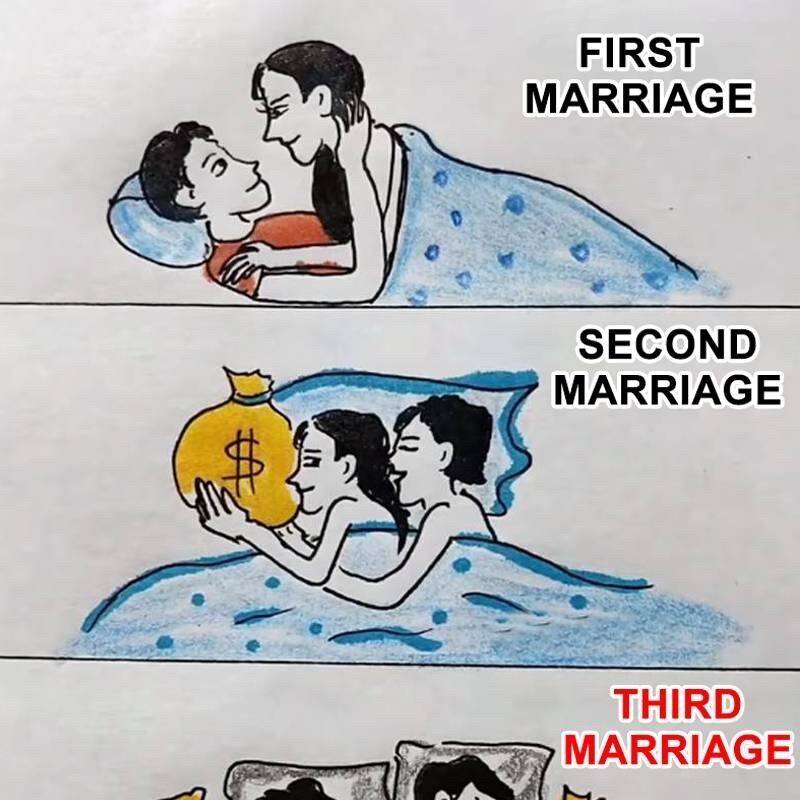
Marriage has long been seen as one of the most important milestones in life. It represents partnership, stability, and the merging of two lives into one. But as with anything else in life, the meaning of marriage is not static—it evolves as people grow older, face challenges, and learn from past experiences.
The viral illustration comparing the first, second, and third marriages may be humorous, but it captures a truth that resonates with many. It suggests that with each marriage, priorities shift—from love and passion, to financial security, to comfort and peace. While not universally true, these stages highlight the way life’s lessons shape our choices in relationships.
Let’s take a closer look at what this progression really means, and why so many people find themselves redefining marriage over time.
The First Marriage: Love and Dreams at the Center
For most people, the first marriage is filled with hope, idealism, and the belief that love conquers all. It’s often a union sparked by youthful passion and romantic ideals rather than practical considerations.
Also Read : The Hidden Dangers of Certain Pills: What You Need to Know
At this stage, couples are usually younger, with fewer responsibilities and less life experience. Love is the fuel that drives them forward. Conversations revolve around shared dreams, future plans, and perhaps even starting a family. The emotional bond is strong, and both partners tend to believe that affection and commitment are enough to overcome any obstacle.
Strengths of the First Marriage:
- Deep emotional connection and intimacy.
- Shared excitement about building a life together.
- Fewer distractions from financial or practical concerns.
Challenges of the First Marriage:
- Naivety about the realities of long-term partnership.
- Struggles with financial pressures, career building, or parenting stress.
- Idealism that may not withstand life’s inevitable hardships.
It’s no surprise that some first marriages don’t last. Love is essential, but love alone is rarely enough to sustain a partnership through decades of financial strain, health issues, or personal growth that pulls people in different directions.
The Second Marriage: Searching for Stability and Security
By the time someone enters a second marriage, they are often older, wiser, and shaped by the lessons of the first. Divorce or loss has already shown them what can go wrong, and they are usually more cautious.
Also Read : These Are the 8 Signs That Indicate You Have Too Much Sugar in Your Body
In this stage, many people prioritize stability—both emotional and financial. Love is still important, but it may no longer be the sole foundation. Couples often look for partners who can provide balance, reliability, and practical security. Money, lifestyle, and shared values around finances become central concerns.
Why Money Matters More This Time:
- Divorce can be financially devastating, leaving people more cautious.
- By this stage, individuals may have children or assets to protect.
- People often want a partner who contributes equally or complements their financial stability.
This doesn’t mean that second marriages are purely transactional. In fact, many are deeply loving. But they tend to be built with both the heart and the head. People entering a second marriage often have clearer expectations, stronger boundaries, and a willingness to discuss uncomfortable topics like money, family responsibilities, and long-term goals.
The Third Marriage: Prioritizing Peace and Comfort
By the time someone enters a third marriage, their priorities often shift again. After experiencing both the highs of love and the lessons of loss or disappointment, they may no longer be seeking fireworks or financial gain. Instead, they crave peace, companionship, and comfort.
This stage is less about proving anything and more about simply enjoying life. For many, it’s about finding someone who understands them deeply, accepts their flaws, and shares a vision of a calm and fulfilling partnership.
What Defines Third Marriages:
- A desire for emotional peace over passion.
- A focus on companionship rather than appearances.
- Less interest in societal expectations—more focus on personal happiness.
These marriages may not carry the intensity of the first or the financial negotiations of the second, but they often bring a deeper, quieter satisfaction.
Do All Marriages Follow This Pattern?
Of course, not every marriage fits neatly into this progression. Some first marriages last a lifetime, blending love, financial stability, and comfort into one lasting union. Others may skip a step—finding peace in a second marriage instead of waiting for a third.
Cultural, personal, and generational differences also shape the way people approach marriage. In some cultures, financial security has always been the top priority, even in the first marriage. In others, love remains the non-negotiable foundation, regardless of age or experience.
What’s important to recognize is that marriage evolves with the people inside it. As individuals grow, change careers, raise children, or face personal challenges, their vision of what makes a marriage “successful” changes too.
Lessons We Can Learn From This Evolution
- Love is essential—but not enough on its own.
Passion creates strong beginnings, but marriages require communication, compromise, and resilience to last. - Practicality matters.
Ignoring finances, lifestyle compatibility, or future goals can lead to unnecessary conflict. A strong marriage balances romance with realism. - Peace is priceless.
In the end, most people realize that happiness doesn’t come from drama or wealth—it comes from feeling understood, respected, and at ease with your partner.
Conclusion: Marriage as a Journey, Not a Destination
The illustration comparing first, second, and third marriages may simplify things into a quick laugh, but it also points to a deeper truth: marriage is not static. It shifts, evolves, and reflects the lessons we learn along the way.
The first marriage is often about love and dreams, the second about stability and security, and the third about comfort and peace. But no matter how many times someone walks down the aisle, the true goal remains the same: to find a partnership that nurtures both the heart and the soul.
Marriage, in the end, is less about where you start and more about where you finish—finding someone who makes life not just bearable, but beautiful.





1 thought on “The Biggest Difference Between First, Second, and Third Marriages”